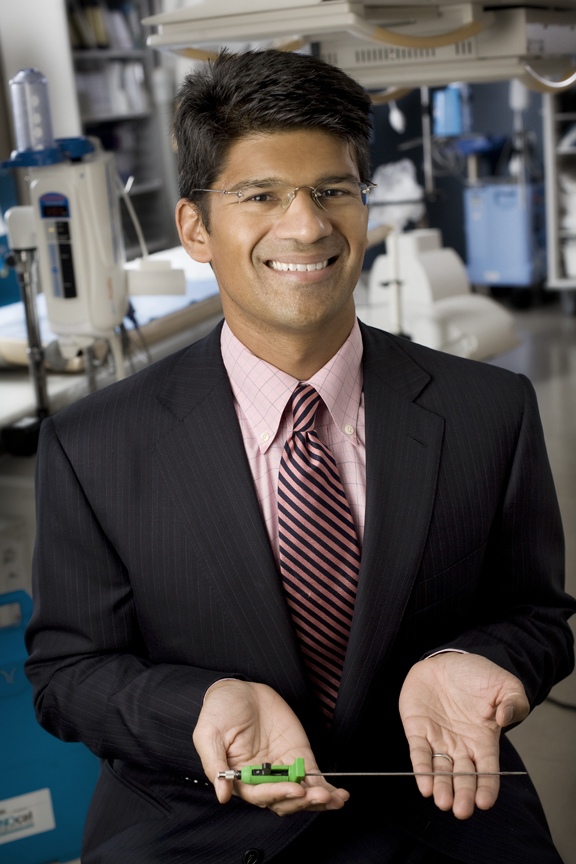The University of Virginia Patent Foundation is celebrating its 30th year of dedicated service to the University's faculty, staff and student inventors. In that time, the Patent Foundation has generated more than $36.6 million in revenue for the University and distributed an additional $18.4 million to University inventors and their collaborators
All this week on UVA Today, we will be running profiles of University inventors who were honored by the Patent Foundation this past year. (Dec. 16, 2008)
Srijoy Mahapatra, M.D.
Biomedical Engineering and Internal Medicine
Sometimes what makes a technology a "breakthrough" is the fact that it doesn't break through at all. Take, for example, the novel epicardial ablation techniques developed by Dr. Srijoy Mahapatra. While current treatments for heart problems such as congestive heart failure center on surgical techniques, he seeks to treat the heart from the outside, without breaking through the heart’s tissue.
"The heart is surrounded by a one-millimeter wide, fluid-filled sac — that, by the way, you can’t even see on X-ray," said Mahapatra, an assistant professor of internal medicine and biomedical engineering at U.Va. The new tools allow doctors to go through that sac to the epicardium — the heart’s outermost tissue — without actually entering the heart, "reducing patients' risk and recovery time," he added.
Among these new tools is an "epi-needle access system," which includes a retractable needle and a sensor capable of measuring the pressure and pressure frequency of surrounding tissues. Developed with George T. Gillies, this revolutionary access system acts as a scope and thus requires only one 3-millimeter incision, making it much less invasive than surgical methods.
"Any time you reduce the risks of a procedure, as we have done with the epi-needle, you make treatment available to more people," Mahapatra said. "Because this technology is less invasive, we can use it to treat people who are currently not being treated."
That is good news for patients suffering from heart failure, atrial fibrillation, ventricular tachycardia and esophageal failure, all of whom could be helped by the scientists' new epicardial technology. With its advanced precision, the epi-needle can also be used for safer pacemaker insertion, ablation techniques, stem cell delivery and drug delivery throughout the body, and it will reduce the risk of stroke associated with atrial fibrillation.
The epi-needle is the first of a suite of epicardial technologies developed by Mahapatra and Gillies and disclosed to the U.Va. Patent Foundation.
"We are fortunate here at U.Va. to have inventive medical doctors like Srijoy, who can foresee novel solutions to clinical needs," said Gillies, research professor of mechanical and biomedical engineering. "It is indeed a pleasure to work with him on these exciting technologies."
Mahapatra sees invention as an important and natural part of his work, and he encourages fellow clinicians to embark on paths to discovery through open, weekly discussions held in his office.
"I love taking a problem and solving it by creating a tool that you can use with your hands to help patients," he said.
All this week on UVA Today, we will be running profiles of University inventors who were honored by the Patent Foundation this past year. (Dec. 16, 2008)
Srijoy Mahapatra, M.D.
Biomedical Engineering and Internal Medicine
Sometimes what makes a technology a "breakthrough" is the fact that it doesn't break through at all. Take, for example, the novel epicardial ablation techniques developed by Dr. Srijoy Mahapatra. While current treatments for heart problems such as congestive heart failure center on surgical techniques, he seeks to treat the heart from the outside, without breaking through the heart’s tissue.
"The heart is surrounded by a one-millimeter wide, fluid-filled sac — that, by the way, you can’t even see on X-ray," said Mahapatra, an assistant professor of internal medicine and biomedical engineering at U.Va. The new tools allow doctors to go through that sac to the epicardium — the heart’s outermost tissue — without actually entering the heart, "reducing patients' risk and recovery time," he added.
Among these new tools is an "epi-needle access system," which includes a retractable needle and a sensor capable of measuring the pressure and pressure frequency of surrounding tissues. Developed with George T. Gillies, this revolutionary access system acts as a scope and thus requires only one 3-millimeter incision, making it much less invasive than surgical methods.
"Any time you reduce the risks of a procedure, as we have done with the epi-needle, you make treatment available to more people," Mahapatra said. "Because this technology is less invasive, we can use it to treat people who are currently not being treated."
That is good news for patients suffering from heart failure, atrial fibrillation, ventricular tachycardia and esophageal failure, all of whom could be helped by the scientists' new epicardial technology. With its advanced precision, the epi-needle can also be used for safer pacemaker insertion, ablation techniques, stem cell delivery and drug delivery throughout the body, and it will reduce the risk of stroke associated with atrial fibrillation.
The epi-needle is the first of a suite of epicardial technologies developed by Mahapatra and Gillies and disclosed to the U.Va. Patent Foundation.
"We are fortunate here at U.Va. to have inventive medical doctors like Srijoy, who can foresee novel solutions to clinical needs," said Gillies, research professor of mechanical and biomedical engineering. "It is indeed a pleasure to work with him on these exciting technologies."
Mahapatra sees invention as an important and natural part of his work, and he encourages fellow clinicians to embark on paths to discovery through open, weekly discussions held in his office.
"I love taking a problem and solving it by creating a tool that you can use with your hands to help patients," he said.
Media Contact
Article Information
December 16, 2008
/content/inventor-profile-revolutionizing-access-human-heart

